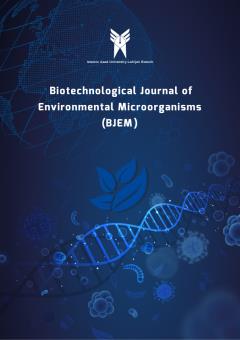ZnO-Rutin nanoparticles: a potent formulation to inhibit Staphylococcus aureus biofilm
Subject Areas : Biotechnological Journal of Environmental Microbiology
Fatemeh Azizi Alidoust
1
,
Behnam Rasti
2
![]() ,
Hojjatola Zamani
3
,
Mirsasan Mirpour
4
,
َAmir Mirzaei
5
,
Hojjatola Zamani
3
,
Mirsasan Mirpour
4
,
َAmir Mirzaei
5
1 - Department of Microbiology, Faculty of Basic Sciences, Lahijan Branch, Islamic Azad University, Lahijan, Guilan, Iran
2 - Department of Microbiology, Faculty of Basic Sciences, Lahijan Branch, Islamic Azad University, Lahijan, Guilan, Iran
3 - Department of Biology, University of Guilan, Rasht, Iran
4 - Department of Microbiology, Faculty of Basic Sciences, Lahijan Branch, Islamic Azad University, Lahijan, Guilan, Iran
5 - Department of Biology, Parand Branch, Islamic Azad University, Parand, Iran
Keywords: Biofilm, Drug resistance, Rutin, ZnO ,
Abstract :
Staphylococcus aureus is a major human pathogen. This opportunistic pathogen is responsible for a variety of infections in humans. Biofilm formation is a key factor in infection development and drug resistance. Biofilm acts as a barrier and reduces bacterial exposure to antibacterial drugs. Targeting bacterial biofilm is a promising strategy to overcome drug resistance. In this work, the antibiofilm potential of ZnO-rutin nanoparticles was characterized. Growth inhibitory potential was studied using the broth microdilution method. Biofilm inhibitory effects of ZnO and ZnO-rutin nanoparticles were investigated by crystal staining and electron microscopy imaging was used to visualize the treated and untreated biofilms. The minimum inhibitory concentration (MIC) of the ZnO and ZnO-rutin nanoparticles for S. aureus strains was 0.5-1.0µg/mL. Treatment of S. aureus with ZnO and ZnO-rutin nanoparticles inhibited biofilm formation by 68.2 and 81.2%, respectively. In addition, exposure of S. aureus with ZnO-rutin nanoparticles considerably disrupted biofilm architecture, inhibited cell adhesion to the surface, and caused morphological alteration of biofilm architecture. Additionally, damage to cell surface was evident in the treated cells. This study shows that ZnO-rutin can be a promising candidate for combating biofilm-associated infection and drug resistance caused by S. aureus.
Alvarez, M. D. L. A., Debattista, N. B., & Pappano, N. B. (2006). Synergism of flavonoids with bacteriostatic action gainst Staphylococcus aureus ATCC 25 923 and Escherichia coli ATCC 25 922. Biocell, 30(1), 39-42.
Amin, M. U., Khurram, M., Khattak, B., & Khan, J. (2015). Antibiotic additive and synergistic action of rutin, morin and quercetin against methicillin resistant Staphylococcus aureus. BMC complementary and alternative medicine, 15, 1-12.
Alves, M. M., Bouchami, O., Tavares, A., Cordoba, L., Santos, C. F., Miragaia, M., & de Fátima Montemor, M. (2017). New insights into antibiofilm effect of a nanosized ZnO coating against the pathogenic methicillin resistant Staphylococcus aureus. ACS applied materials & interfaces, 9(34), 28157-28167.
Alidoust, F. A., Rasti, B., Zamani, H., Mirpour, M., & Mirzaie, A. (2024). Rutin-coated zinc oxide nanoparticles: a promising antivirulence formulation against pathogenic bacteria. World Journal of Microbiology and Biotechnology, 40(6), 184.
Arima, H., Ashida, H., & Danno, G. I. (2002). Rutin-enhanced antibacterial activities of flavonoids against Bacillus cereus and Salmonella enteritidis. Bioscience, biotechnology, and biochemistry, 66(5), 1009-1014.
Cheung, G. Y., Bae, J. S., & Otto, M. (2021). Pathogenicity and virulence of Staphylococcus aureus. Virulence, 12(1), 547-569.
Das, S., & Dash, H. R. Microbial biotechnology-A laboratory manual for bacterial systems. Springer, 2014.
Khan, F., Kang, M.G., Jo, D.M., Chandika, P., Jung, W.K., Kang, H.W., Kim, Y.M. (2021). Phloroglucinol-Gold and -Zinc Oxide Nanoparticles: Antibiofilm and Antivirulence Activities towards Pseudomonas aeruginosa PAO1. Mar. Drugs. 19 (11), 601.
Konkuri, M., Kharrazi, S., Erfani, Y., & Haghighat, S. (2024). Antibacterial and antibiofilm effect of Zinc Oxide nanoparticles on P. aeruginosa variants isolated from young patients with cystic fibrosis. Microbial Pathogenesis, 195, 106854.
Koo, H., Allan, R. N., Howlin, R. P., Stoodley, P., & Hall-Stoodley, L. (2017). Targeting microbial biofilms: current and prospective therapeutic strategies. Nature Reviews Microbiology, 15(12), 740-755.
Liu, W. T., Chen, E. Z., Yang, L., Peng, C., Wang, Q., Xu, Z., & Chen, D. Q. (2021). Emerging resistance mechanisms for 4 types of common anti-MRSA antibiotics in Staphylococcus aureus: A comprehensive review. Microbial pathogenesis, 156, 104915.
Mlynarczyk-Bonikowska, B., Kowalewski, C., Krolak-Ulinska, A., & Marusza, W. (2022). Molecular mechanisms of drug resistance in Staphylococcus aureus. International journal of molecular sciences, 23(15), 8088.
Negahdari, R., Bohlouli, S., Sharifi, S., Maleki Dizaj, S., Rahbar Saadat, Y., Khezri, K., ... & Raeesi, S. (2021). Therapeutic benefits of rutin and its nanoformulations. Phytotherapy Research, 35(4), 1719-1738. https://doi.org/10.1002/ptr.6904
Parastan, R., Kargar, M., Solhjoo, K., & Kafilzadeh, F. (2020). Staphylococcus aureus biofilms: Structures, antibiotic resistance, inhibition, and vaccines. Gene Reports, 20, 100739.
Rizzello, L., Cingolani, R., & Pompa, P. P. (2013). Nanotechnology tools for antibacterial materials. Nanomedicine, 8(5), 807-821.
Senobar Tahaei, S. A., Stájer, A., Barrak, I., Ostorházi, E., Szabó, D., & Gajdács, M. (2021). Correlation between biofilm-formation and the antibiotic resistant phenotype in Staphylococcus aureus isolates: a laboratory-based study in Hungary and a review of the literature. Infection and drug resistance, 1155-1168.
Zahmatkesh, H., Mirpour, M., Zamani, H., & Rasti, B. (2023). Effect of samarium oxide nanoparticles fabricated by curcumin on efflux pump and virulence genes expression in MDR Pseudomonas aeruginosa and Staphylococcus aureus. Journal of Cluster Science, 34(3), 1227-1235.


